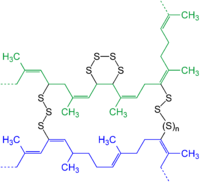
Photo from wikipedia
Tools to interrogate glycoconjugate-protein interactions in the context of living cells are highly attractive for the identification of critically important functional binding partners of glycan-binding proteins. These interactions are challenging… Click to show full abstract
Tools to interrogate glycoconjugate-protein interactions in the context of living cells are highly attractive for the identification of critically important functional binding partners of glycan-binding proteins. These interactions are challenging to study due to the low affinity and rapid dissociation rates of glycan-protein binding events. The use of photo-cross-linkers to capture glycan-protein interaction complexes has shown great promise for identifying binding partners involved in these interactions. Current methodologies use metabolic oligosaccharide engineering (MOE) to incorporate photo-cross-linking sugars. However, these MOE strategies are not amenable to all cell types and can result in low incorporation and cell-surface display of the photo-cross-linking probe, limiting their utility for studying many types of interactions. We describe here an exo-enzymatic strategy for selectively introducing photo-cross-linking probes into cell-surface glycoconjugates using the recombinant human sialyltransferase ST6GAL1 and a diazirine-linked CMP-Neu5Ac derivative. Probe introduction is highly efficient, amenable to different cell types, and resulted in improved cross-linking when compared to MOE. This exo-enzymatic labeling approach can selectively introduce the photo-cross-linking sugar onto specific glycan epitopes and subclasses by harnessing the specificity of the sialyltransferase employed, underscoring its potential as a tool to interrogate and identify glycoconjugate ligands for diverse glycan-binding proteins.
Journal Title: Bioconjugate chemistry
Year Published: 2022
Link to full text (if available)
Share on Social Media: Sign Up to like & get
recommendations!